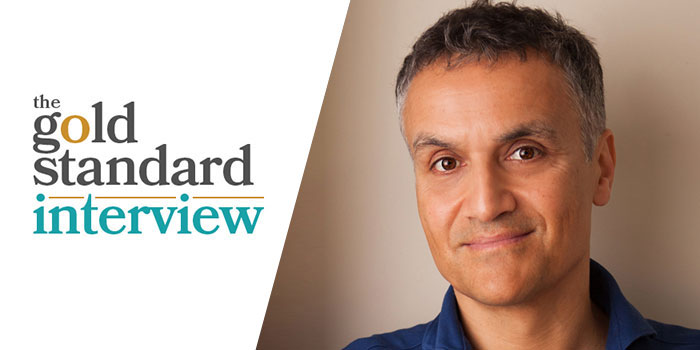

Rita Silvan, editor-in-chief of Golden Girl Finance, talks with Carl Honoré, bestselling author of In Praise of Slow, and more recently, Bolder: Making the Most of Our Longer Lives, about the 100-year life, a changing workplace, financial independence, and a new definition of aging well.
GGF: Carl, your book could not be timelier. In Canada, the fastest-growing age group is the over-100s! Another Canadian statistic is that seniors have the fastest-growing debt levels. It’s great that we’re living longer, but our money has to last longer too at a time when interest rates on savings are at historical lows and fewer workers have any kind of pension at all. Women are really in a bind because we earn less than men and pay more for goods and services because of the “pink tax”. What needs to change?
CH: The short answer is nobody has a short answer, or else we wouldn’t be asking this question. I haven’t seen a clear recipe on how we put this right. We need more than tweaks in the workplace.
We need to shake up the typical three-stage career arc where, at the end, we fall off the cliff edge into retirement. Also, the financial system needs to be more flexible, so we can save for retirement in different ways. There needs to be a longer savings arc. For example, start saving in our 20s, even if it’s $10 per month, then maybe dip into our savings, for 5 or 6 years, during child rearing, and then ramp up again when we re-enter the workforce. There should be a more flexible pension pot. I see ad-hoc changes, but we need a sea-change from financial institutions to make this possible.
We also have this double-edged sword when it comes to workplace seniority. Seniority is equated with higher pay, but this makes keeping and hiring older workers too expensive. Labour codes should be rewritten: pay people based on what they offer, not how old they are. Give people the freedom to take sabbaticals, to make sideway career choices. We need to let go of this idea that our careers and salaries should only move upwards.
GGF: When we think of “successful aging”, particularly for women, we imagine women who are slim, fit, have swingy, expensive-looking hair… former supermodel Cindy Crawford once told a magazine that there’s no longer a time in a woman’s life when she can just relax about maintaining her appearance. Our society is literally ‘anti-aging’, and this fuels the entire beauty/wellness industrial complex that is very costly to women. In your book you quote that it’s a US$250 billion industry. What is the media’s role in keeping these prejudices against natural aging alive?
CH: In my book I talk about Getty Images, a leading stock photo agency, who, in 2016, used web-crawling technology to explore images of older people online and found that they were usually shown alone, unhappy, sedentary, or sipping tea in bed. These are the stereotypical images that we see all the time—they’re the wallpaper—in news stories and ad and marketing campaigns. Yet, they don’t reflect genuine aging.
I think the shift in perceptions is coming in stages. We are redefining what attractive looks like. It used to only someone who is young and slim and with glossy hair. Now we’re widening the lens to include someone with silver hair, maybe a few more pounds. We’re still in the first stage. Women like Helen Mirren and others who are in ad campaigns are helping to push the door open. Ideally, we want no door, so everyone can march through.
Social media actually has the potential to drive that. It used to be that tablets were handed down to us about what’s attractive. Increasingly, we’re creating our own versions. We’re changing the wallpaper. My daughter, who is 17, is coming of age in a very different world about what looks good. Of course, humans are programmed to find symbols of fertility attractive and that will always be there but, today, I feel there is a widening range of what’s considered attractive.
GGF: One negative and persistent trope is the “bag lady”: an older, single woman living in near poverty in a dingy studio apartment feeding her cats until they eventually eat her. This image is very real to a lot of women, even those who are successful in their careers and have solid net-worth. However, the “bag lady” fear is not unreasonable because senior women are twice as likely as men to live in poverty. Do you think showing more examples of happy, well-off women will diminish the fear factor and make women confidently seek financial independence?
CH: I was in Holland last week at an event. The woman organizing it was 55 and single and was planning to purchase an apartment in an assisted-living residence. She was moving out of her house to avoid becoming a bag lady.
What we see becomes not only what we aspire to but also what we fear. The woman I spoke to at Getty Images was the Director of Creative Insight and she admitted that she hadn’t really thought about the downbeat and bleak images of older people that the company sold and that ended up in advertising. We need to change the media picture by posting images of women in their 60s, 70s and up doing great things, like setting up an orphanage in the Third World and creating companies. I never see images like that. Yet, millions of women are doing those things but they’re invisible. We need to make them visible by telling those stories.
I think we also need to tear down the silos across generations by bringing older workers back into the workforce as mentors, for example. Let the 80-somethings mingle with the 20-somethings to shape a different version of their own futures. As culture flattens out—we listen to the same music, watch the same programs on Netflix—we need to change the idea that aging is like carrying a giant rucksack of boulders. That’s a gruesome stereotype and not genuine.
One very bright spot is that women are colonizing online. They are forming support groups, telling their own stories, starting on-line forums. It’s like an iceberg hidden below the surface. It’s a new frontier and, I think, younger women are finding it a relief—and a gift.
GGF: In the book, you talk about your experience of putting on an “aging suit”—padding, gloves, weights, neck-immobilizer, as well as modified goggles to degrade your eyesight, foam padding to diminish your hearing. How did that experience affect you?
CH: Until then, I was a card-carrying ageist. I pushed my future self away. After wearing the suit, I found myself talking to people in a different way, talking to my parents in a way I didn’t before. The experience of wearing the suit was so traumatic for me that I initially thought of throwing this book project away. It was horrific. Fortunately, right after wearing the suit, I visited a cycling championship where people 30 years older than me were whizzing round the track in a blur of Lycra—that helped get me back on track!
One of the benefits of doing the book was to focus my mind on my future self. I think differently about money now. Until my 30s I hadn’t been a big saver even though I come from Scottish stock and have the frugal gene. Now at 51, I am more “long-term-ist”. Wearing the suit made me realize that, one day, I will be slower, weaker and frailer. If we can get young people, even those in their teens, relating more to their older selves, they’ll have more skin in the game and be better savers.
GGF: Putting on an aging suit is one thing, but what about an aging brain? Some studies show that, as early as our 50s, we make poorer financial decisions and are more susceptible to cognitive and emotional biases?
CH: I’ve seen some data that, as we age, we might become a bit slower in solving math problems or lose some memory recall, but most of our cognition stays the same and some things actually get better. In other words, the “full English breakfast” of aging doesn’t happen all at once. There are some figures on dementia that about 17 per cent of people over 80 suffer from it, but that means that 83 per cent do not—and most of those will suffer little, if any, cognitive decline at all. So, I’ve yet to see any clear data on older people making poorer financial decisions. If that were the case, I could see an argument for some form of state involvement to protect seniors, for example, making financial advice free or very inexpensive. That said, why not make financial advice free or cheap for everyone at every age?
GGF: In your research for the book, did you see any data on a rise in “elder hate”? Because Gen-X and Boomers have mostly benefited from buoyant real estate, stock and job markets, as well as private and government pensions, so they’ve managed to do quite well financially. Those fortunate circumstances are not in place for millennials and Gen-Z. Is this likely to cause more intergenerational frictions?
CH: It’s hard to get reliable data on this. If you research for “elder abuse”, as a set phrase, it seems to be as bad, but not worse, than before. Here in Britain, there’s been a generational split related to Brexit, where more of the older generation voted to leave the European Union and the younger generations voted to stay. But intergenerational friction is nothing new: you find evidence of it going back thousands of years. Even the Romans and Ancient Greeks were at it!
GGF: Thank you Carl for this enlightening and inspiring conversation!
Enter to win one of 5 free copies of Carl Honoré’s book, Bolder: Making the Most of Our Longer Lives







